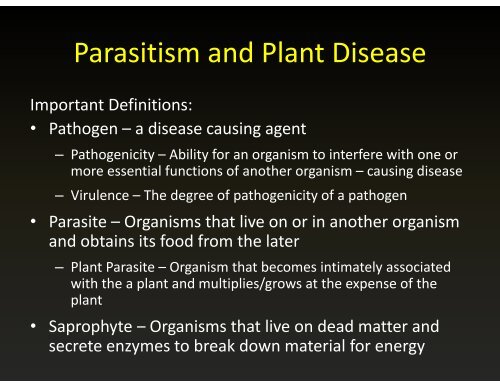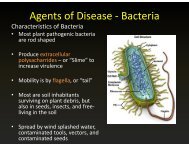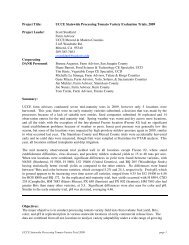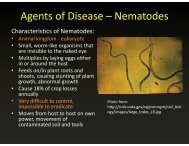Parasitism and Plant Disease
Parasitism and Plant Disease
Parasitism and Plant Disease
You also want an ePaper? Increase the reach of your titles
YUMPU automatically turns print PDFs into web optimized ePapers that Google loves.
<strong>Parasitism</strong> <strong>and</strong> <strong>Plant</strong> <strong>Disease</strong><br />
Important Dfiii Definitions:<br />
• Pathogen –a disease causing agent<br />
– Pathogenicity – Ability for an organism to interfere with one or<br />
more essential functions of another organism –causing disease<br />
– Virulence – The degree of pathogenicity of a pathogen<br />
• Parasite – Organisms that live on or in another organism<br />
<strong>and</strong> obtains its food from the later<br />
– <strong>Plant</strong> Parasite –Organism that becomes intimately associated<br />
with the a plant <strong>and</strong> multiplies/grows at the expense of the<br />
plant<br />
• Saprophyte – Organisms that live on dead matter <strong>and</strong><br />
p p y g<br />
secrete enzymes to break down material for energy
<strong>Parasitism</strong> <strong>and</strong> <strong>Plant</strong> <strong>Disease</strong><br />
Pathogen Spectrum<br />
Non‐ Obligate Parasites<br />
Facultative<br />
Saprophytes<br />
Facultative<br />
Parasites<br />
Obligate Parasites<br />
(Biotrophs)<br />
Obligate Saprophytes<br />
(Necrotrophs)
<strong>Parasitism</strong> <strong>and</strong> <strong>Plant</strong> <strong>Disease</strong><br />
Parasites<br />
• Tend to have narrow host<br />
range – except viruses<br />
• Does not need to kill plant<br />
cells to complete lifecycle<br />
• Intimate relationship with<br />
plant – continuous<br />
absorption of nutrients<br />
• Grows inter‐ <strong>and</strong> intra‐<br />
cellulary<br />
l<br />
• Infected plants tend to be<br />
stunted, poor vigor<br />
• “Vampires”<br />
Saprophytes<br />
• Tend to have broad host<br />
range<br />
• Kills plant tissues to acquire<br />
nutrients for growth <strong>and</strong><br />
complete lifecycle<br />
• Secrete enzymes <strong>and</strong> toxins<br />
• Grows inter‐cellularly<br />
• “Werewolves”
<strong>Parasitism</strong> <strong>and</strong> <strong>Plant</strong> <strong>Disease</strong><br />
<strong>Disease</strong> Triangle<br />
<strong>Disease</strong> occurrence is an<br />
interactive event!<br />
All sides must favor disease for<br />
the disease process to take<br />
place!<br />
Amount of<br />
<strong>Disease</strong><br />
Total of conditions favoring susceptibility<br />
Total of conditions favoring susceptibility<br />
Host
<strong>Parasitism</strong> <strong>and</strong> <strong>Plant</strong> <strong>Disease</strong><br />
Factors affecting the<br />
Pathogen:<br />
1. Virulence<br />
2. Population present<br />
3. Life‐stage of propagule<br />
4. Vectors present<br />
<strong>Disease</strong> Triangle
<strong>Parasitism</strong> <strong>and</strong> <strong>Plant</strong> <strong>Disease</strong><br />
Factors affecting the<br />
Host:<br />
1. Level of resistance<br />
2. Growth stage of plant<br />
3. Genetic uniformity of<br />
neighboring plants<br />
4. <strong>Plant</strong> Vigor<br />
5. <strong>Plant</strong> Density<br />
6. Structure of <strong>Plant</strong><br />
<strong>Disease</strong> Triangle
<strong>Parasitism</strong> <strong>and</strong> <strong>Plant</strong> <strong>Disease</strong><br />
Factors affecting the<br />
Environment:<br />
1. Conditions that favor disease<br />
<strong>Disease</strong> Triangle<br />
2. Conditions that promote plant<br />
growth<br />
3. Conditions that affect dispersal<br />
Includes levels of humidity,<br />
temperature, wind speed, <strong>and</strong><br />
periods of rain
<strong>Parasitism</strong> <strong>and</strong> <strong>Plant</strong> <strong>Disease</strong><br />
<strong>Disease</strong> Triangle<br />
Interpretation of the triangle:<br />
‐ Length of each side is<br />
proportional to the sum total<br />
of the characteristics ti of each<br />
component that favors disease<br />
Amount<br />
Amount<br />
of<br />
of<br />
<strong>Disease</strong><br />
<strong>Disease</strong><br />
‐If one side is zero, no disease<br />
‐If one side is very large,<br />
disease potential ti lis large<br />
‐ Quantification of the triangle’s<br />
area would represent the<br />
amount of disease<br />
Amount<br />
of<br />
<strong>Disease</strong><br />
Total of conditions favoring<br />
susceptibility<br />
Host
<strong>Plant</strong> <strong>Disease</strong> Development<br />
<strong>Disease</strong>s are a series of<br />
distinct events that occur<br />
in succession leading to<br />
the perpetuation of the<br />
disease <strong>and</strong> pathogen<br />
This chain of events is called<br />
the disease cycle!<br />
‐Closely related to the<br />
lifecycle of the pathogen
<strong>Plant</strong> <strong>Disease</strong> Development<br />
Host<br />
Recognition<br />
Infection<br />
Invasion<br />
Colonization<br />
Penetration<br />
The <strong>Disease</strong> Cycle<br />
Pathogen<br />
Growth <strong>and</strong>/or<br />
Reproduction<br />
Attachment<br />
Dissemination of 2° 2<br />
Incubation<br />
Inoculum<br />
Dissemination<br />
1° Inoculum<br />
Dormant Period<br />
Symptom<br />
Development<br />
Production of<br />
Dormant Stage
<strong>Plant</strong> <strong>Disease</strong> Development<br />
Pi Primary Events:<br />
1. Inoculation<br />
2. Penetration<br />
3. Establishment of<br />
Infection<br />
4. Invasion<br />
5. Growth <strong>and</strong> reproduction<br />
of the pathogen<br />
(Colonization)<br />
6. Dissemination of the<br />
pathogen<br />
7. Survival in the absence of<br />
the host<br />
2<br />
1<br />
3<br />
The<br />
<strong>Disease</strong><br />
Cycle<br />
7<br />
4<br />
5<br />
6
<strong>Plant</strong> <strong>Disease</strong> Development<br />
1. Inoculation<br />
‐ Initial contact of<br />
pathogen with a<br />
susceptible plant site<br />
‐ Innoculum: pathogen<br />
brought into infection<br />
court<br />
‐ May be spores, sclerotia,<br />
mycelial fragments,<br />
bacteria, or viruses<br />
‐ Primary inoculum –<br />
primary infection<br />
‐ Secondary inoculum –<br />
secondary infection<br />
Inoculum Sources<br />
‐ Survival in perennial<br />
plants, weeds,<br />
contaminated soil, soil<br />
debris, seeds,<br />
transplants, <strong>and</strong> vectors<br />
Arrival of inoculum<br />
1. Passively (i.e. wind)<br />
2. Chemotaxis – organisms<br />
within the soil are<br />
attracted to plant roots<br />
3. Vector‐transmitted (i.e.<br />
insects)
<strong>Plant</strong> <strong>Disease</strong> Development<br />
2. Penetration 2.4 Recognition between host <strong>and</strong><br />
2.1 Attachment to host<br />
‐ Fungi <strong>and</strong> bacteria produce<br />
gelatinous substances to help<br />
them stick to leaf surface<br />
22Spore 2.2 germination<br />
‐ Mainly Fungi –spore germinates<br />
forming germ tube <strong>and</strong> moves<br />
along host to find opening/weak<br />
point<br />
23Appressorium 2.3 Formation<br />
‐ Fungi only – Formation of<br />
appressorium <strong>and</strong> “softening<br />
enzymes” <strong>and</strong> prepares p for<br />
penetration into plant<br />
pathogen<br />
‐ Triggers plant resistance genes –if<br />
present –promotes /prevents<br />
infection<br />
2.5 Penetration<br />
‐ Direct – Formation of appressorium,<br />
<strong>and</strong> penetration peg<br />
‐ Indirect<br />
‐wounds ‐ wind/growth cracks,<br />
wind blown s<strong>and</strong>, lesions<br />
caused by other pathogens,<br />
vectors<br />
‐natural openings ‐ Stomata,<br />
hydrathodes, lenticels
<strong>Plant</strong> <strong>Disease</strong> Development<br />
2. Penetration (cont.)<br />
Agrios, 1997
<strong>Plant</strong> <strong>Disease</strong> Development<br />
2. Penetration (cont.)<br />
Photos from: Read, N.D. , Kellock, L.J.,<br />
Knight, H., Trewavas, A.J. (1992b). Contact<br />
sensing during infection by fungal<br />
pathogens.
<strong>Plant</strong> <strong>Disease</strong> Development<br />
3. Establishment of Infection<br />
‐ Infection: Process by which<br />
pathogens establish contact with<br />
susceptible cells <strong>and</strong> procure<br />
nutrients ti t<br />
‐ Successful infections result in<br />
symptoms –visibly iibl detectable dt tbl<br />
changes in the plant<br />
‐ Obligate fungal parasites form<br />
haustoria ‐ intracellular “vampires”<br />
‐ Pth Pathogen releases enzymes, toxins,<br />
<strong>and</strong> growth regulators<br />
‐ <strong>Plant</strong> reacts with defense df<br />
mechanisms<br />
Photos from: Read, N.D. , Kellock, L.J.,<br />
Knight, H., Trewavas, A.J. (1992b). Contact<br />
sensing during infection by fungal<br />
pathogens.
<strong>Plant</strong> <strong>Disease</strong> Development<br />
4. Invasion<br />
Pathogens spread through plant<br />
Fungi <strong>and</strong> bacteria: Spread by<br />
intracellular <strong>and</strong> intercellular<br />
growth by using enzymes <strong>and</strong><br />
hormones, localized<br />
li Nematodes: Move intercellularly,<br />
localized<br />
Viruses, Viroids, <strong>and</strong><br />
xylem/phloem limited bacteria:<br />
Move cell to cell intracellularly,<br />
systemic
<strong>Plant</strong> <strong>Disease</strong> Development<br />
5. Growth <strong>and</strong> reproduction<br />
of the pathogen<br />
(Colonization)<br />
‐ Pathogens continue to<br />
spread until the infection is<br />
stopped or the plant is dead<br />
‐ Only fungi <strong>and</strong> nematodes<br />
can actively move<br />
‐ All other pathogens rely rapid<br />
reproduction <strong>and</strong> being<br />
passively moved
<strong>Plant</strong> <strong>Disease</strong> Development<br />
5. Growth <strong>and</strong> reproduction of<br />
the pathogen (Colonization)<br />
‐ Reproduction:<br />
‐ Fungi –spores, inter‐ <strong>and</strong><br />
intra‐, surface <strong>and</strong> interior<br />
‐ Bacteria –cell division, inter<strong>and</strong><br />
intra‐, surface <strong>and</strong> interior<br />
‐ Viruses –intra‐, inside cells<br />
only<br />
‐ Nematodes –inter‐ <strong>and</strong><br />
intra‐, surface <strong>and</strong> interior<br />
‐ Parasitic <strong>Plant</strong>s – seeds,<br />
exterior of plant only<br />
Rate varies on pathogen present,<br />
environment, <strong>and</strong> host
<strong>Plant</strong> <strong>Disease</strong> Development<br />
6. Dissemination of pathogen<br />
Agrios, 1997
<strong>Plant</strong> <strong>Disease</strong> Development<br />
7. Survival of pathogen<br />
without a host<br />
(Overwintering stage)<br />
Fungi: mycelium in cankers, bud<br />
scales, seeds, tubers, <strong>and</strong> plant<br />
debris; spores; <strong>and</strong> sclerotia<br />
‐ Soil inhabitants –survive<br />
in soil indefinitely<br />
(saprophytes)<br />
p ‐ Soil transients –survive in<br />
soil for short period of time<br />
(parasites)<br />
Parasitic <strong>Plant</strong>s: Seeds <strong>and</strong><br />
vegetative from on host<br />
Bacteria: same way as fungi;<br />
infected plants, seeds, tubers,<br />
<strong>and</strong> plant debris; in the bodies of<br />
insect vectors. Survive better in<br />
large slimy colonies than as small<br />
groups.<br />
Viruses: survive only in living<br />
plant tissues; roots of perennial<br />
plants, seeds of some hosts, <strong>and</strong><br />
insect vectors.<br />
Nematodes: Survive as eggs in<br />
the soil; or lifestages that are<br />
dormant in seeds <strong>and</strong> bulbs
<strong>Plant</strong> <strong>Disease</strong> Development<br />
7. Survival of pathogen without a host<br />
Agrios, 1997
<strong>Plant</strong> <strong>Disease</strong> Development<br />
<strong>Disease</strong> Epidemics:<br />
Monocyclic: completes 1 disease cycle in a<br />
year<br />
‐ 1° inoculum is only inoculum for<br />
entire year<br />
‐ <strong>Disease</strong> increases year to year as<br />
inoculum builds<br />
1° inoculum<br />
1° infection<br />
Over‐seasoning Stage<br />
Polycyclic: 2or more disease cycles in a year<br />
‐ most pathogens<br />
‐ disseminated by air, <strong>and</strong> airborne<br />
vectors<br />
‐ create explosive epidemics –Late<br />
Blight, Powdery Mildew, <strong>and</strong> Rusts<br />
1° inoculum<br />
2° infection<br />
1° infection<br />
2° inoculum<br />
Polyetic – requiring two or more years to<br />
complete lifecycle (considered<br />
monocyclic)<br />
‐ typical of many vascular wilt<br />
pathogens –Dutch Elm <strong>Disease</strong><br />
Over‐seasoning Stage







